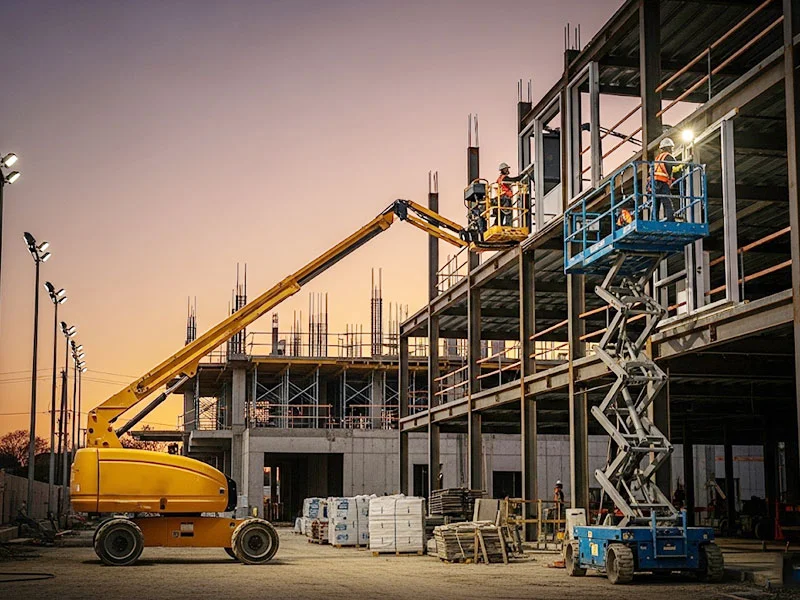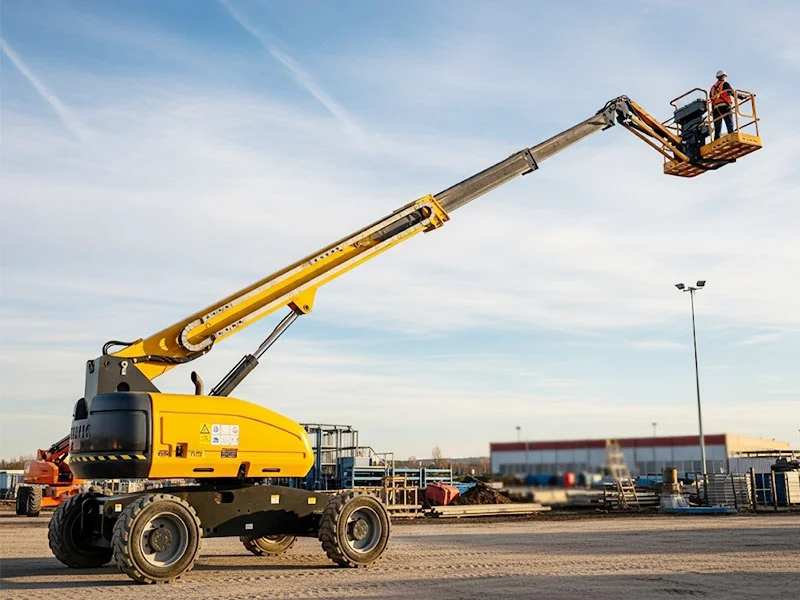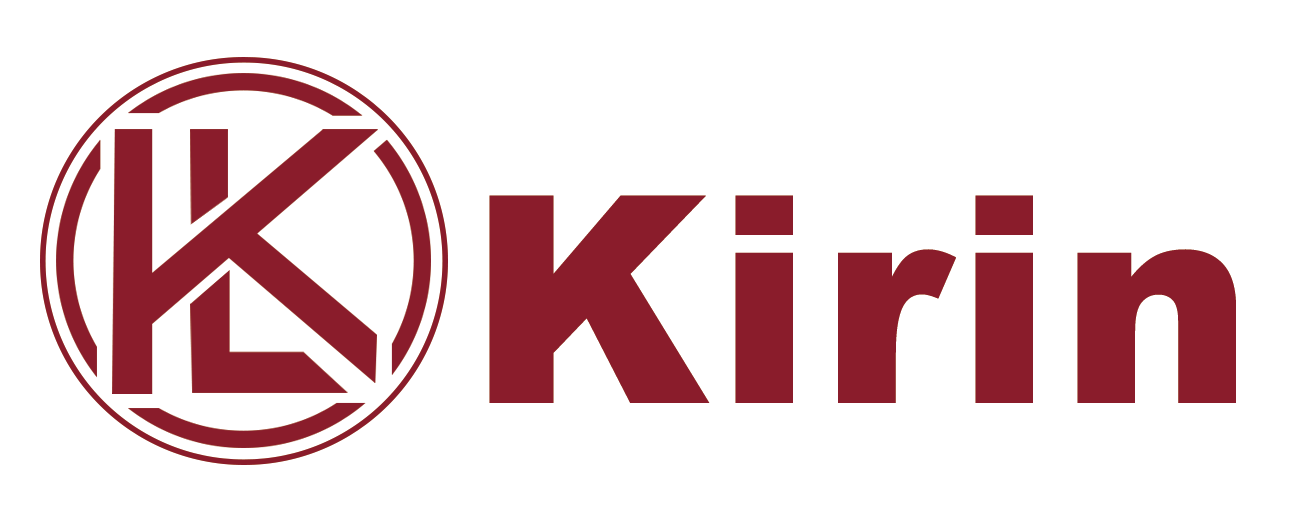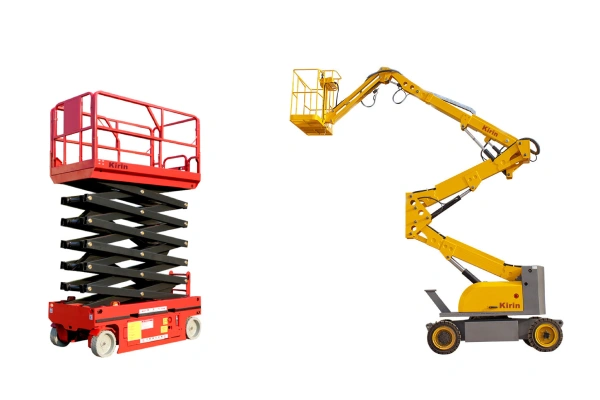When it comes to working at height, safety and efficiency are paramount. Aerial working platforms (AWPs) are indispensable tools that enable workers to reach elevated areas, perform maintenance, construction, and various other tasks. However, with several types available, choosing the right one can be a critical decision. Two of the most common and often debated options are the boom lift vs scissor lift. This guide will help you understand the nuances of each and make an informed choice for your next project.

Understanding the Scissor Lift
A scissor lift is a mobile elevated work platform (MEWP) that moves vertically. Its distinctive criss-crossing support mechanism, resembling a pair of scissors when extended, allows the work platform to rise straight up. Scissor lifts are known for their stable and spacious platforms, making them ideal for tasks that require multiple workers or materials to be lifted directly upwards.
Pros of choosing a scissor lift:
- Large Work Platform: Offers ample space for workers, tools, and materials.
- High Weight Capacity: Can typically lift more weight than many boom lifts.
- Stability: Provides a very stable working environment due to its robust base and vertical movement.
- Ease of Use: Generally simpler to operate compared to boom lifts.
- Cost-Effective: Often a more budget-friendly option for vertical access.
Cons of choosing a scissor lift:
- Limited Horizontal Reach: Can only move straight up and down, with no outward reach.
- Less Versatile: Not suitable for tasks requiring navigation around obstacles or reaching over obstructions.
- Can Be Bulky: Larger models might have difficulty maneuvering in tight spaces.
Types of Scissor Lift:
- Electric Scissor Lift: Ideal for indoor use due to zero emissions and quiet operation. They are typically powered by batteries and suitable for finished surfaces.
- Diesel Scissor Lift: Designed for outdoor and rough terrain applications, offering more power and greater lift capacity. They are often equipped with four-wheel drive.
- Steering Scissor Lifts: While most scissor lifts have steering capabilities, this term can sometimes refer to models with enhanced maneuverability or more precise steering control, which is a standard feature on most self-propelled units.
- Tracked Scissor Lift: Equipped with tracks instead of wheels, providing superior traction and stability on uneven or soft ground, making them excellent for challenging outdoor environments.

Understanding the Boom Lift
What Is A Boom Lift?
A boom lift, also known as a cherry picker or a man lift, is an aerial work platform with a hydraulic arm (or “boom”) that can extend both vertically and horizontally. This allows the operator to reach areas that are otherwise inaccessible, often navigating around obstacles or reaching over structures. The boom can articulate, telescope, or both, offering a wide range of motion.
Pros of choosing a boom lift:
- Exceptional Reach: Offers unparalleled horizontal and vertical reach, allowing access to difficult-to-reach areas.
- Versatility: Can maneuver around obstacles, making them suitable for complex job sites.
- Compact Footprint (for some types): Articulating models can have a relatively small footprint while offering significant reach.
- Maneuverability: Excellent for navigating tight spaces and reaching over obstructions.
Cons of choosing a boom lift:
- Smaller Work Platform: The platform is generally smaller, accommodating fewer workers and less material.
- Lower Weight Capacity: Typically has a lower weight capacity compared to scissor lifts.
- More Complex to Operate: Requires more training and skill to operate safely and effectively.
- Higher Cost: Generally more expensive to purchase or rent than scissor lifts.
Types of Boom Lift:
- Articulated Boom Lift: Features multiple sections that “articulate” or bend, similar to a knuckle. This allows them to reach up and over obstacles, making them highly versatile for complex work sites.
- Telescopic Boom Lift: Also known as a “straight boom” or “stick boom,” these lifts have a boom that extends in a straight line, offering the greatest horizontal reach among boom lifts. Ideal for tasks requiring direct, long-distance reach.
- Towable Boom Lift: Designed to be easily towed behind a truck, these lifts are lighter and more portable, making them suitable for smaller projects or for contractors who need to transport the lift between various job sites.
- Crawler Spider Lift: These compact, lightweight boom lifts are mounted on tracks, giving them excellent stability and maneuverability on uneven terrain and delicate surfaces. Their “spider-like” outriggers allow them to level on slopes.

Boom Lift vs. Scissor Lift: A Direct Comparison
Understanding the fundamental differences between a boom lift vs scissor lift is crucial for selecting the right equipment. The following table highlights key distinctions:
| Feature | Scissor Lift | Boom Lift |
| Movement | Primarily vertical | Vertical and horizontal (articulating/telescoping) |
| Work Platform | Large, spacious | Smaller, more compact |
| Reach | Limited to vertical height | Extensive horizontal and vertical reach |
| Maneuverability | Good for straight up, limited around obstacles | Excellent for navigating obstacles and tight spaces |
| Weight Capacity | Higher (often several workers + materials) | Lower (typically 1-2 workers + tools) |
| Stability | Highly stable | Stable, but requires careful positioning for maximum reach |
| Cost | Generally lower rental/purchase cost | Generally higher rental/purchase cost |
| Ideal Use | Tasks requiring direct vertical access (e.g., façade work, indoor maintenance, warehousing) | Tasks requiring reach over/around obstacles (e.g., tree trimming, building inspection, complex construction) |
How to Choose the Right Aerial Working Platform? (Decision Factors)
When faced with the boom lift vs scissor lift dilemma, consider these crucial factors:
1.Job Site Environment:
- Indoors vs. Outdoors: Electric scissor lifts are perfect for indoor, finished surfaces due to no emissions and quiet operation. Diesel scissor lifts and boom lifts are better suited for outdoor, rough terrain.
- Obstacles and Terrain: If your site has many obstacles or uneven ground, a boom lift’s articulation and reach will be invaluable. For flat, open spaces, a scissor lift is more efficient.
- Space Constraints: Consider the width and turning radius. Some boom lifts are more compact than larger scissor lifts.
2.Required Reach and Height:
- Pure Vertical Access: If you only need to go straight up to a certain height with no horizontal obstructions, a scissor lift is likely sufficient.
- Horizontal Outreach: If you need to reach over equipment, structures, or landscaping, a boom lift is essential. Pay close attention to the specific horizontal outreach specifications.
3.Weight Capacity and Number of Workers:
- Multiple Workers/Heavy Materials: If your task requires several workers, heavy tools, or significant materials on the platform, a scissor lift’s higher weight capacity will be a major advantage.
- One or Two Workers: For tasks with fewer personnel and lighter equipment, a boom lift’s capacity is usually adequate.
4.Type of Work:
- Straight-Up Tasks: Installation of ceiling tiles, painting walls, shelving, or general maintenance in warehouses are ideal for scissor boom lifts.
- Complex Access: Building façade work, bridge inspection, reaching over power lines, or challenging construction scenarios often demand the flexibility of a boom lift.
- Repetitive Tasks: If you’re frequently moving along a straight line at height (e.g., painting a long wall), a scissor lift’s larger platform and stability can be more efficient.
5.Budget Considerations:
- Rental vs. Purchase: Both boom lifts and scissor lifts are available for rent or purchase. Consider the frequency of use. For occasional projects, renting is more economical.
- Operating Costs: Factor in fuel/electricity consumption, maintenance, and potential transport costs. Generally, scissor boom lifts have lower operating costs.
6.Safety and Training:
- Operator Skill: Boom lifts require more advanced operator training due to their complex movements. Scissor lifts are generally simpler to operate.
- Site-Specific Hazards: Always conduct a thorough site assessment to identify potential hazards and ensure the chosen AWP can operate safely within those conditions. Adherence to safety regulations and proper training are non-negotiable for both types of lifts.
Conclusion
The decision between a boom lift vs scissor lift is not about one being inherently “better” than the other, but rather about which aerial working platform is best suited for your specific project needs. By carefully evaluating your job site environment, required reach, weight capacity, type of work, budget, and safety considerations, you can confidently select the aerial lift that will maximize efficiency, productivity, and most importantly, safety for your elevated tasks. Always prioritize proper training and adherence to all safety guidelines regardless of the equipment you choose.
FAQs
Q1: Can a scissor lift be used on uneven ground?
A1: While some larger, rough-terrain diesel scissor lifts are designed for uneven ground and come with auto-leveling outriggers, standard electric scissor lifts are generally meant for flat, stable surfaces. For significantly uneven or soft terrain, a tracked scissor lift or a boom lift might be a safer choice.
Q2: What is the maximum height a boom lift can reach?
A2: Boom lifts come in a wide range of sizes. Smaller towable boom lifts might reach 30-40 feet, while large telescopic boom lifts can extend over 180 feet, and even reach heights of over 200 feet for specialized models.
Q3: Are boom lifts more dangerous than scissor lifts?
A3: Both types of lifts can be dangerous if not operated correctly. However, boom lifts, due to their greater range of motion and often higher reach, can present more complex stability challenges and require a higher level of operator skill and awareness to prevent tip-overs or collisions. Scissor lifts are generally more stable due to their vertical movement, but still require strict adherence to safety protocols.
Q4: Do I need a special license to operate a boom lift or scissor lift?
A4: While specific licensing requirements vary by region and country, in most places, operators are required to undergo formal training and certification for both boom lifts and scissor lifts. This ensures they understand safe operation, inspection, and emergency procedures. Always check local regulations.
Q5: Can I use an outdoor scissor lift indoors?
A5: While possible, it’s generally not recommended for electric-only indoor environments. Diesel scissor lifts produce emissions and are often heavier, potentially damaging indoor flooring. Their larger size might also make them impractical for tight indoor spaces. Electric scissor lifts are specifically designed for indoor use.


